Water Demand in Maize Is Projected to Decrease under Changing Climate in India
Abstract
:1. Introduction
2. Materials and Methods
2.1. Study Locations
2.2. Collection of Crop Data
2.3. Weather Data–Baseline and Projected
2.3.1. Baseline Climate Data
2.3.2. Projected Climate Data
2.4. Computation of Crop and Irrigation Water Requirement
2.4.1. Estimation of Sowing Time
2.4.2. Estimation of Crop Phenology
2.4.3. Estimation of Crop and Irrigation Water Requirements
2.5. Impact of Projected Climate on Phenology, Crop and Irrigation Water Requirement
3. Results
3.1. Projected Climate
3.1.1. Seasonal Rainfall
3.1.2. Tmax
3.1.3. Tmin
3.2. Changes in Phenology under Future Climate
3.3. Changes in Crop Water Requirement
3.4. Changes in Irrigation Water Requirement
4. Discussion
5. Conclusions
Supplementary Materials
Author Contributions
Funding
Institutional Review Board Statement
Informed Consent Statement
Data Availability Statement
Conflicts of Interest
References
- WWAP (UNESCO World Water Assessment Programme). The United Nations World Water Development Report 2019: Leaving No One Behind; UNESCO: Paris, France, 2019. [Google Scholar]
- United Nations. Open Working Group of the General Assembly on Sustainable Development Goals. Issued as Document A/68/970. 2014. Available online: http://undocs.org/A/68/970 (accessed on 25 October 2021).
- Surendran, U.; Sandeep, O.; Mammen, G.; Joseph, E.J. A Novel technique of magnetic treatment of saline and hard water for irrigation and its impact on cow pea growth and water properties. Int. J. Agric. Environ. Biotechnol. 2013, 6, 85–92. [Google Scholar]
- Jalota, S.K.; Kaur, H.; Ray, S.S.; Tripathi, R.; Vashisht, B.B.; Bal, S.K. Mitigating Future Climate Change Effects by Shifting Planting Dates of Crops in Rice-Wheat Cropping System. Reg. Environ. Chang. 2012, 12, 913–922. [Google Scholar] [CrossRef]
- Mukherjee, J.; Bal, S.K.; Singh, G.; Bhattacharya, B.K.; Singh, H.; Kaur, P. Surface energy fluxes in wheat (Triticum aestivum L.) under irrigated ecosystem. J. Agrometeorol. 2012, 14, 16–20. [Google Scholar]
- IPCC. Summary for Policymakers. In Climate Change 2021: The Physical Science Basis. Contribution of Working Group I to the Sixth Assessment Report of the Intergovernmental Panel on Climate Change; Masson, D.V., Zhai, P., Pirani, A., Connors, S.L., Péan, C., Berger, S., Caud, N., Chen, Y., Goldfarb, L., Gomis, M.I., et al., Eds.; Cambridge University Press: Cambridge, UK, 2021. [Google Scholar]
- Chen, P.; Liu, Y. The impact of climate change on summer maize phenology in the northwest plain of Shandong province under the IPCC SRES A1B scenario. IOP Conf. Ser. Earth Environ. Sci. 2014, 17, 012053. [Google Scholar] [CrossRef] [Green Version]
- Hatfield, J.L.; Prueger, J.H. Temperature extremes: Effect on plant growth and development. Weather. Clim. Extrem. 2015, 10, 4–10. [Google Scholar] [CrossRef] [Green Version]
- Tubiello, F.N.; Donatelli, M.; Rosenzweig, C.; Stockle, C.O. Effects of climate change and elevated CO2 on cropping systems: Model predictions at two Italian locations. Eur. J. Agron. 2000, 13, 179–189. [Google Scholar] [CrossRef]
- Tao, F.; Yokozawa, M.; Xu, Y.; Hayashi, Y.; Zhang, Z. Climate changes and trends in phenology and yields of field crops in China, 1981–2000. Agric. For. Meteorol. 2006, 138, 82–92. [Google Scholar] [CrossRef]
- Wang, J.; Vanga, S.; Saxena, R.; Orsat, V.; Raghavan, V. Effect of climate change on the yield of cereal crops: A review. Climate 2018, 6, 41. [Google Scholar] [CrossRef] [Green Version]
- Tryjanowski, P.; Sparks, T.H.; Blecharczyk, A.; Małecka-Jankowiak, I.; Switek, S.; Sawinska, Z. Changing phenology of potato and of the treatment for its major pest (Colorado potato beetle)–a long-term analysis. Am. J. Potato Res. 2018, 95, 26–32. [Google Scholar] [CrossRef] [Green Version]
- Ahmad, S.; Abbas, Q.; Abbas, G.; Fatima, Z.; Naz, S.; Younis, H.; Khan, R.J.; Nasim, W.; Habib ur Rehman, M.; Ahmad, A.; et al. Quantification of climate warming and crop management impacts on cotton phenology. Plants 2017, 6, 7. [Google Scholar] [CrossRef] [Green Version]
- Woznicki, S.A.; Nejadhashemi, A.P.; Parsinejad, M. Climate change and irrigation demand: Uncertainty and adaptation. J. Hydrol. Reg. Stud. 2015, 3, 247–264. [Google Scholar] [CrossRef]
- Rahman, A.; Mojid, M.A.; Banu, S. Climate change impact assessment on three major crops in the north-central region of Bangladesh using DSSAT. Int. J. Agric. Biol. 2018, 11, 135–143. [Google Scholar] [CrossRef]
- Crop Production Statistics Information System. Available online: https://aps.dac.gov.in/APY/Public_Report1.aspx (accessed on 10 September 2021).
- India Maize Scenario. Available online: https://iimr.icar.gov.in/india-maze-scenario/ (accessed on 1 November 2021).
- Amarasinghe, U.A.; Singh, O.P. Changing consumption patterns of India: Implications on future food demand. In India’s Water Future: Scenarios and Issues; Amarasinghe, U.A., Shah, T., Malik, R.P.S., Eds.; International Water Management Institute: Colombo, Sri Lanka, 2008; pp. 131–146. [Google Scholar]
- Maize Production Technologies in India. Available online: https://farmer.gov.in/imagedefault/pestanddiseasescrops/normalmaizeproductiontechnologies.pdf (accessed on 6 December 2021).
- India Meteorological Department (IMD). Available online: https://www.imdpune.gov.in/Clim_Pred_LRF_New/Grided_Data_Download.html (accessed on 16 August 2021).
- Pai, D.S.; Latha Sridhar Rajeevan, M.; Sreejith, O.P.; Satbhai, N.S.; Mukhopadhyay, B. Development of a new high spatial resolution (0.25° × 0.25°) Long period (1901–2010) daily gridded rainfall data set over India and its comparison with existing data sets over the region. Mausam 2014, 65, 1–18. [Google Scholar] [CrossRef]
- Srivastava, A.K.; Rajeevan, M.; Kshirsagar, S.R. Development of high resolution daily gridded temperature data set (1969–2005) for the Indian Region. Atmos. Sci. Lett. 2009, 10, 249–254. [Google Scholar] [CrossRef]
- Ruane, A.C.; McDermid, S.P. Selection of a representative subset of global climate models that captures the profile of regional changes for integrated climate impacts assessment. Earth Perspect. 2017, 4, 1. [Google Scholar] [CrossRef] [Green Version]
- Robinson, J.M.; Hubbard, K.G. Soil water assessment model for several crops in the High Plains. J. Agron. 1990, 82, 1141–1148. [Google Scholar] [CrossRef] [Green Version]
- Vijaya Kumar, P.; Bal, S.K.; Dhakar, R.; Sarath Chandran, M.A.; Subba Rao, A.V.M.; Sandeep, V.M.; Pramod, V.P.; Malleswari, S.N.; Sudhakar, G.; Solanki, N.S.; et al. Algorithms for weather-based management decisions in major rainfed crops of India: Validation using data from multi-location field experiments. J. Agron. 2021, 113, 1816–1830. [Google Scholar] [CrossRef]
- Ritchie, J.T.; Nesmith, D.S. Temperature and crop development. In Modeling Plant and Soil Systems; Hanks, R.J., Ritchie, J.T., Eds.; Agronomy Monograph-31: Madison, WI, USA, 1991; pp. 5–29. [Google Scholar]
- McMaster, G.S.; Wilhelm, W.W. Growing degree-days: One equation, two interpretations. Agric. For. Meteorol. 1997, 87, 291–300. [Google Scholar] [CrossRef] [Green Version]
- Xu, H.; Tian, Z.; He, X.; Wang, J.; Sun, L.; Fischer, G.; Fan, D.; Zhong, H.; Wu, W.; Pope, E.; et al. Future increases in irrigation water requirement challenge the water-food nexus in the northeast farming region of China. Agric. Water Manag. 2019, 213, 594–604. [Google Scholar] [CrossRef]
- Bal, S.K.; Minhas, P.S. Atmospheric Stressors: Challenges and Coping Strategies. In Abiotic Stress Management for Resilient Agriculture; Minhas, P.S., Rane, J., Pasala, R.K., Eds.; Springer: Singapore, 2017; pp. 9–50. [Google Scholar] [CrossRef]
- Allen, R.G.; Pereira, L.S.; Raes, D.; Smith, M. Crop evapotranspiration-Guidelines for computing crop water requirements-FAO Irrigation and drainage paper 56. FAO Rome 1998, 300, D05109. [Google Scholar]
- Chandran MA, S.; Banerjee, S.; Mukherjee, A.; Nanda, M.K.; Kumari, V.V. Evaluating the long-term impact of projected climate on rice-lentil-groundnut cropping system in Lower Gangetic Plain of India using crop simulation modelling. Int. J. Biometeorol. 2021, 66, 55–69. [Google Scholar] [CrossRef]
- Alfaro, E.J.; Gershunov, A.; Cayan, D. Prediction of summer maximum and minimum temperature over the central and western United States: The roles of soil moisture and sea surface temperature. J. Clim. 2006, 19, 1407–1421. [Google Scholar] [CrossRef]
- Jagadish, S.V.K.; Bahuguna, R.N.; Djanaguiraman, M.; Gamuyao, R.; Vara Prasad, P.V.; Craufurd, P.Q. Implications of high temperature and elevated CO2 on flowering time in plants. Front. Plant Sci. 2016, 7, 913. [Google Scholar] [CrossRef] [Green Version]
- Zhang, Q.; Zhang, W.; Li, T.; Sun, W.; Yu, Y.; Wang, G. Projective analysis of staple food crop productivity in adaptation to future climate change in China. Int. J. Biometeorol. 2017, 61, 1445–1460. [Google Scholar] [CrossRef]
- Guo, Y.; Wu, W.; Du, M.; Liu, X.; Wang, J.; Bryant, C.R. Modelling climate change impacts on rice growth and yield under global warming of 1.5 and 2.0 °C in the Pearl River Delta, China. Atmosphere 2019, 10, 567. [Google Scholar] [CrossRef] [Green Version]
- Chandran, M.A.S.; Banerjee, S.; Mukherjee, A.; Nanda, M.K.; Mondal, S.; Kumari, V.V. Evaluating the impact of projected climate on rice–wheat-groundnut cropping sequence in lower Gangetic plains of India: A study using multiple GCMs, DSSAT model, and long-term sequence analysis. Theor. Appl. Climatol. 2021, 145, 1243–1258. [Google Scholar] [CrossRef]
- Shim, D.; Lee, K.J.; Lee, B.W. Response of phenology-and yield-related traits of maize to elevated temperature in a temperate region. Crop J. 2017, 5, 305–316. [Google Scholar] [CrossRef]
- Durodola, O.S.; Mourad, K.A. Modelling maize yield and water requirements under different climate change scenarios. Climate 2020, 8, 127. [Google Scholar] [CrossRef]
- Ding, Y.; Wang, W.; Song, R.; Shao, Q.; Jiao, X.; Xing, W. Modeling spatial and temporal variability of the impact of climate change on rice irrigation water requirements in the middle and lower reaches of the Yangtze River, China. Agric. Water Manag. 2017, 193, 89–101. [Google Scholar] [CrossRef]
- Li, J.; Zhu, T.; Mao, X.; Adeloye, A.J. Modeling crop water consumption and water productivity in the middle reaches of Heihe River Basin. Comput. Electron. Agric. 2016, 123, 242–255. [Google Scholar] [CrossRef]
- Boonwichai, S.; Shrestha, S.; Babel, M.S.; Weesakul, S.; Datta, A. Climate change impacts on irrigation water requirement, crop water productivity and rice yield in the Songkhram River Basin, Thailand. J. Clean. Prod. 2018, 198, 1157–1164. [Google Scholar] [CrossRef]
- Jalota, S.K.; Kaur, K.; Ray, S.S.; Tripathy, R.; Vashisht, B.B.; Bal, S.K. Past and General Circulation Model-driven future trends of climate change in Central Indian Punjab: Ensuing yield of rice-wheat cropping system. Curr. Sci. 2013, 104, 105–110. [Google Scholar]
- Luhunga, P.M. Assessment of the Impacts of Climate Change on Maize Production in the Southern and Western Highlands Sub-agro Ecological Zones of Tanzania. Front. Environ. Sci. 2017, 5, 51. [Google Scholar] [CrossRef] [Green Version]
- Malhi, G.S.; Kaur, M.; Kaushik, P. Impact of climate change on agriculture and its mitigation strategies: A review. Sustainability 2021, 13, 1318. [Google Scholar] [CrossRef]
- Mali, S.S.; Shirsath, P.B.; Islam, A. A high-resolution assessment of climate change impact on water footprints of cereal production in India. Sci. Rep. 2021, 11, 8715. [Google Scholar] [CrossRef]
- Gabaldón-Leal, C.; Lorite, I.J.; Mínguez, M.I.; Lizaso, J.I.; Dosio, A.; Sanchez, E.; Ruiz-Ramos, M. Strategies for adapting maize to climate change and extreme temperatures in Andalusia, Spain. Clim. Res. 2015, 65, 159–173. [Google Scholar] [CrossRef] [Green Version]
- Yano, T.; Aydin, M.; Haraguchi, T. Impact of climate change on irrigation demand and crop growth in a Mediterranean environment of Turkey. Sensors 2007, 7, 2297–2315. [Google Scholar] [CrossRef] [Green Version]
- Guereña, A.; Ruiz-Ramos, M.; Díaz-Ambrona, C.H.; Conde, J.R.; Mínguez, M.I. Assessment of climate change and agriculture in Spain using climate models. Agron. J. 2001, 93, 237–249. [Google Scholar] [CrossRef]
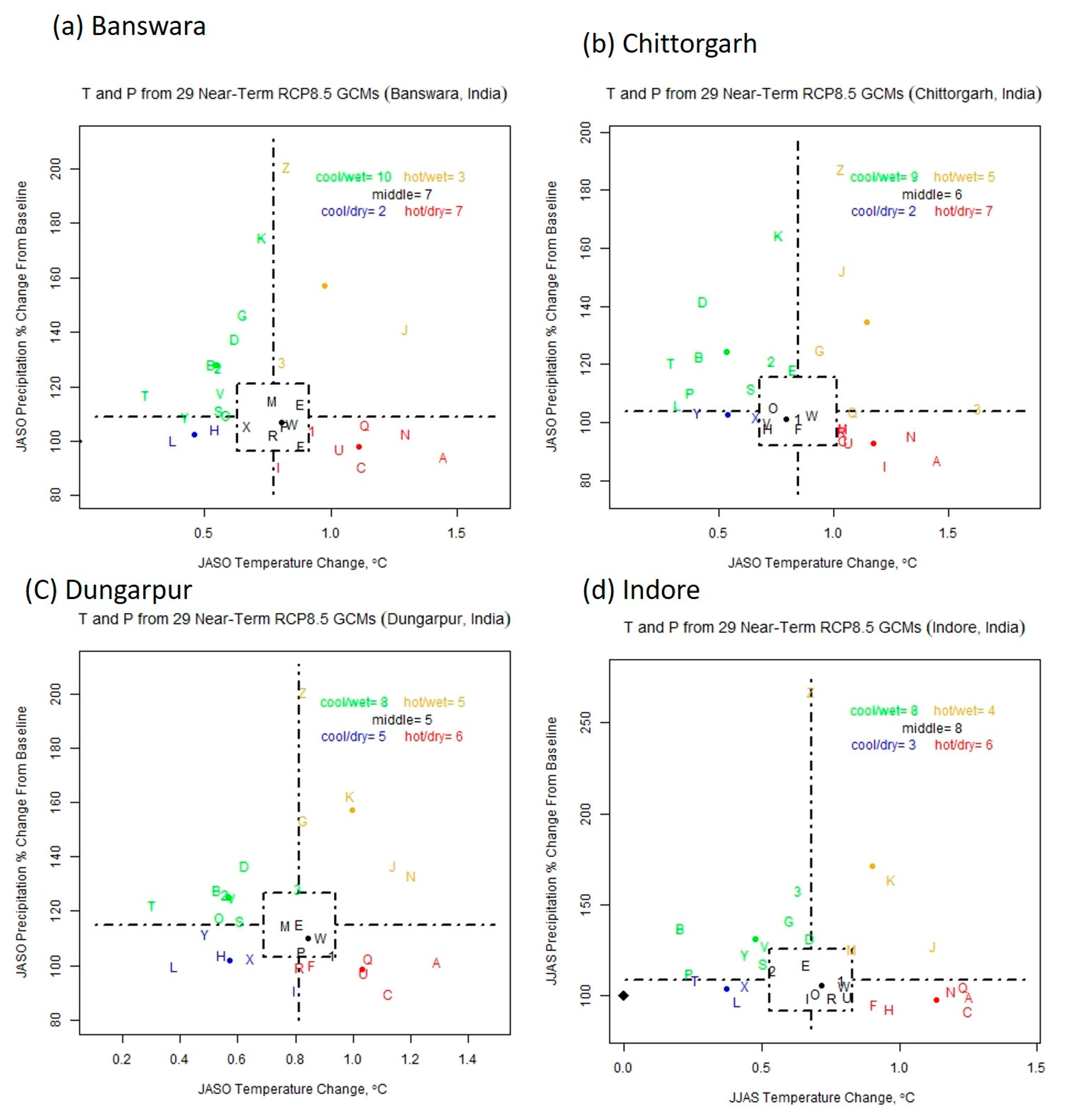
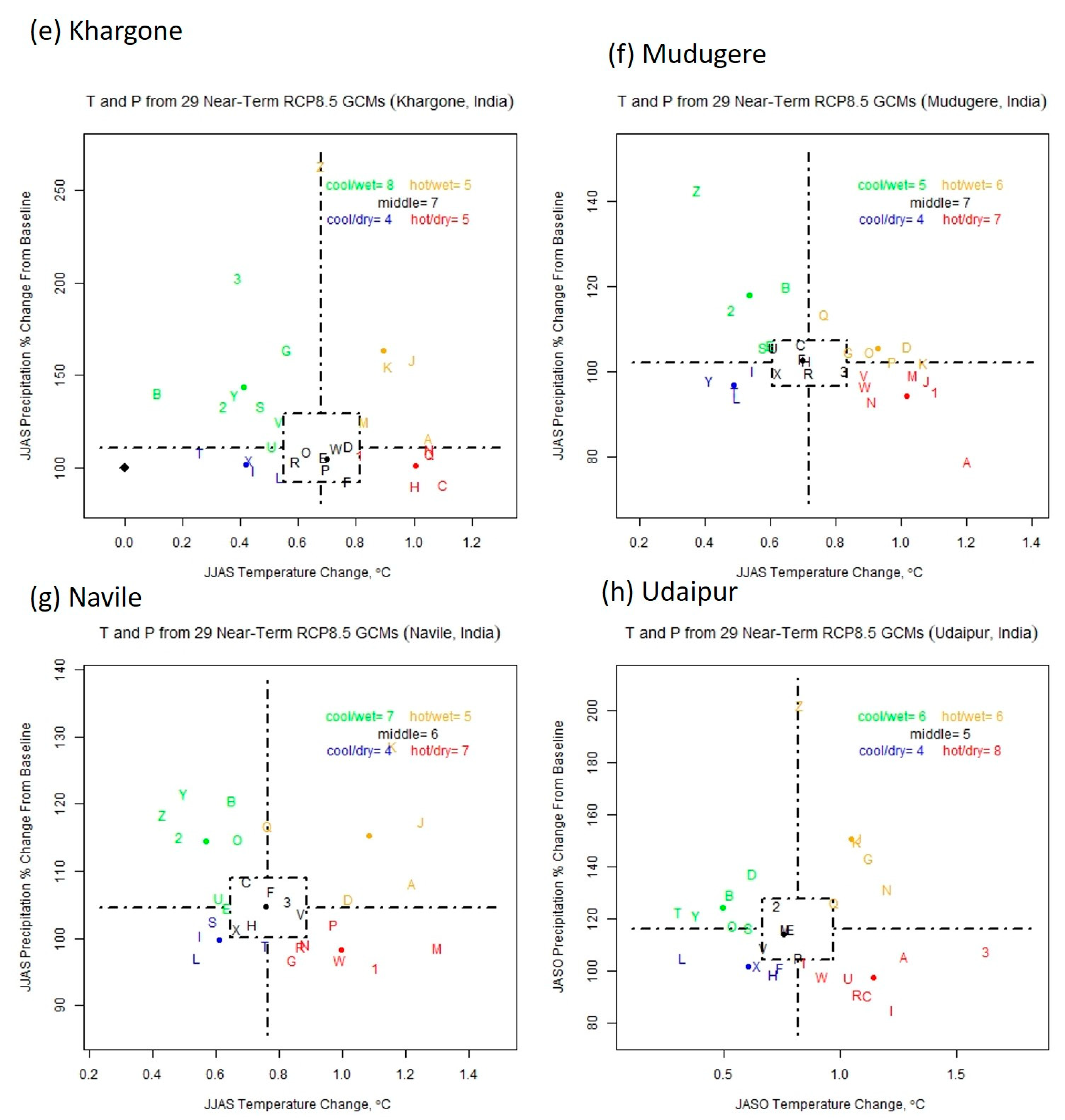
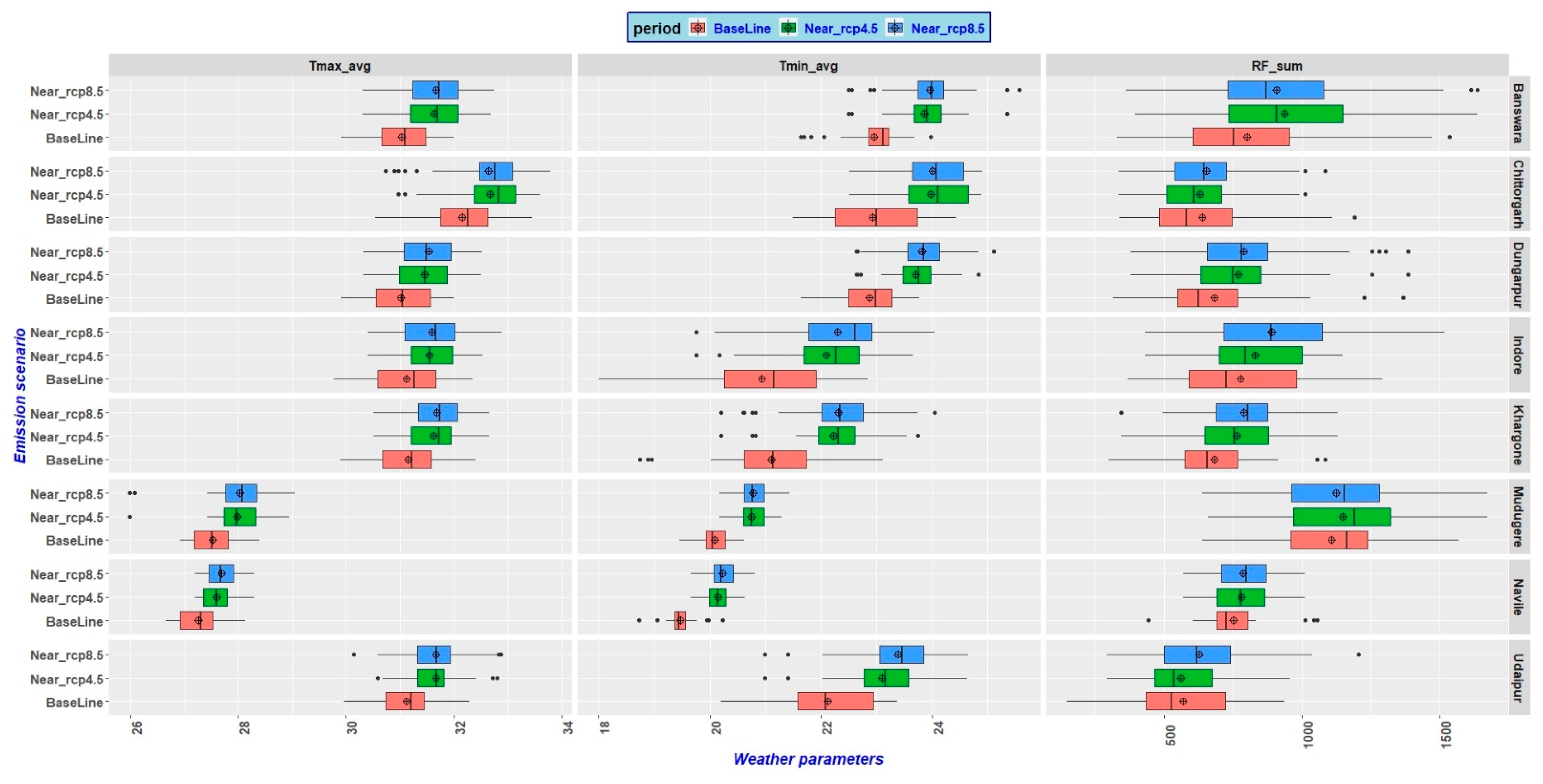
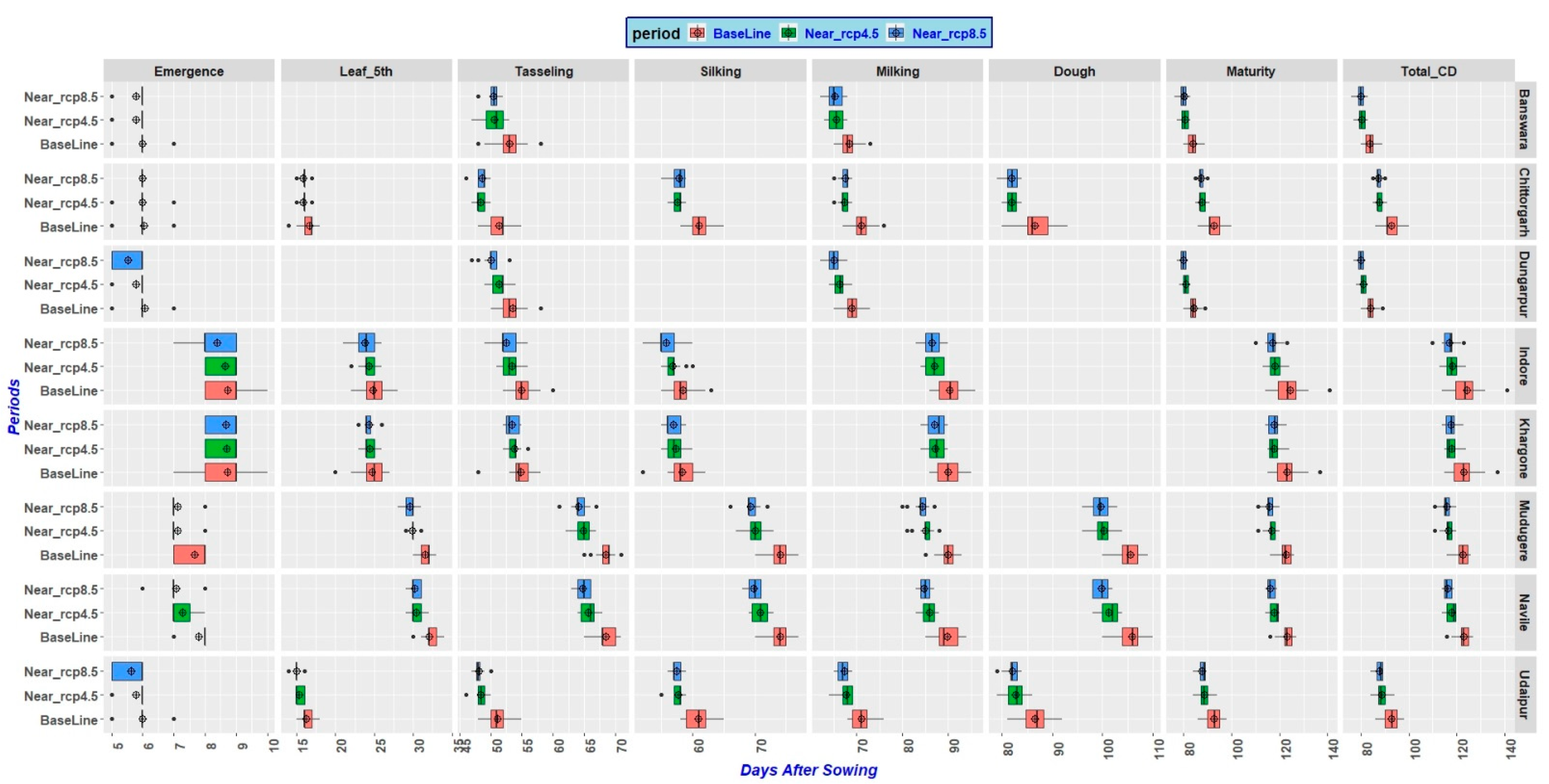

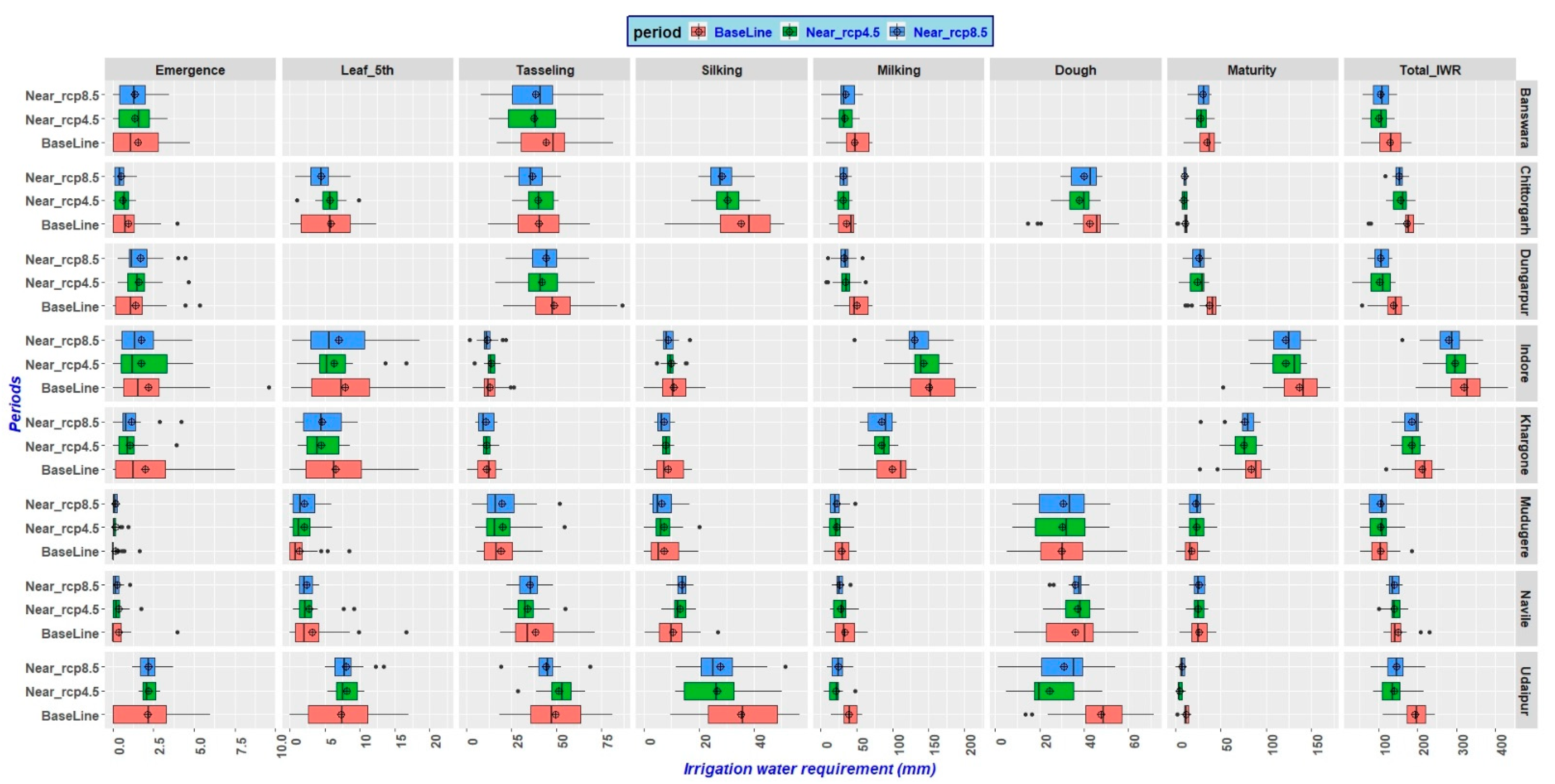
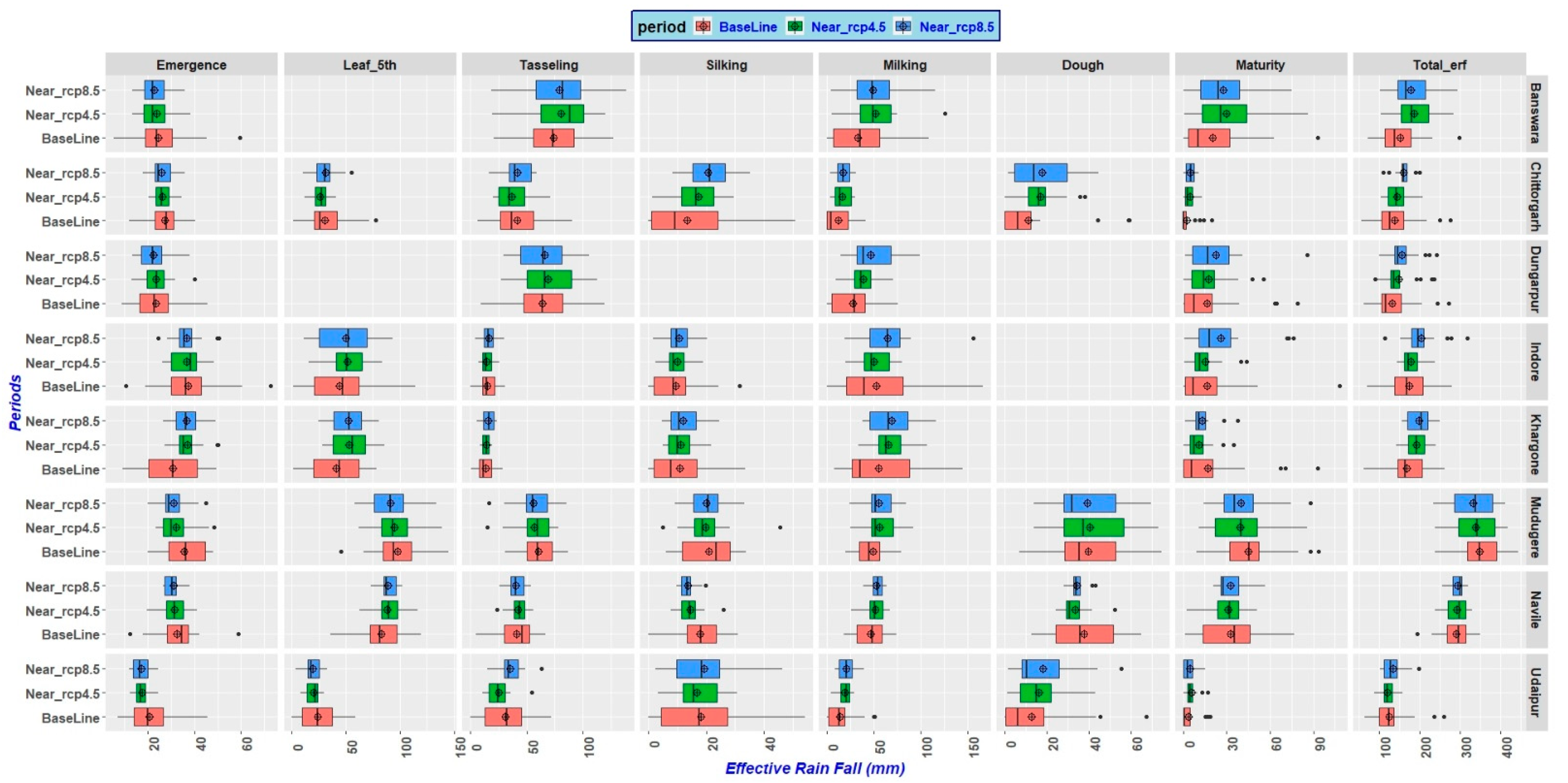
| Location | State | Mean Seasonal Rainfall (mm) | Seasonal Mean Tmax (°C) | Seasonal Mean Tmin (°C) | Soil Texture | Mean Crop Duration |
|---|---|---|---|---|---|---|
| Banswara | Rajasthan | 907 | 32.5 | 23.7 | Sandy loam | 81 |
| Chittorgarh | 772 | 32.6 | 19.1 | Clay loam | 85 | |
| Dungarpur | 774 | 32.5 | 23.7 | Sandy loam | 81 | |
| Udaipur | 685 | 31.8 | 17.5 | Sandy loam | 86 | |
| Indore | Madhya Pradesh | 903 | 32.5 | 22.4 | Silty clay loam | 114 |
| Khargone | 797 | 32.4 | 22.4 | Clay loam | 115 | |
| Mudugere | Karnataka | 1218 | 27.8 | 20.1 | Sandy clay loam | 116 |
| Navile | 827 | 27.4 | 19.6 | Sandy loam | 116 |
| Symbol | GCM | Horizontal Resolution | Symbol | GCM | Horizontal Resolution |
|---|---|---|---|---|---|
| A | ACCESS1-0 | 1.25° × 1.875° | P | MIROC-ESM | ~2.8° × 2.8° |
| B | BCC-CSM 1-1 | ~2.8° × 2.8° | Q | MPI-ESM-LR | ~1.9° × 1.875° |
| C | BNU-ESM | ~2.8° × 2.8° | R | MPI-ESM-MR | ~1.9° × 1.875° |
| D | CanESM2 | ~2.8° × 2.8° | S | MRI-CGCM3 | ~1.1° × 1.125° |
| E | CCSM4 | ~0.9° × 1.25° | T | NorESM1-M | ~1.9° × 2.5° |
| F | CESM1-BGC | ~0.9° × 1.25° | U | FGOALS-g2 | ~2.8° × 2.8° |
| G | CSIRO-Mk3-6-0 | ~1.9° × 1.875° | V | CMCC-CM | ~0.75° × 0.75° |
| H | GFDL-ESM2G | ~2.0° × 2.5° | W | CMCC-CMS | ~1.875° × 1.875° |
| I | GFDL-ESM2M | ~2.0° × 2.5° | X | CNRM-CM5 | ~1.4° × 1.4° |
| J | HadGEM2-CC | 1.25° × 1.875° | Y | HadGEM2-AO | 1.25° × 1.875° |
| K | HadGEM2-ES | 1.25° × 1.875° | Z | IPSL-CM5B-LR | ~2.5° × 1.26° |
| L | INM-CM4.0 | 1.5° × 2.0° | 1 | GFDL-CM3 | 2° × 2.5° |
| M | IPSL-CM5A-LR | ~1.9° × 3.75° | 2 | GISS-E2-R | 2° × 2.5° |
| N | IPSL-CM5A-MR | ~1.3° × 2.5° | 3 | GISS-E2-H | 2° × 2.5° |
| O | MIROC5 | ~1.4° × 1.4° |
| Location | Quadrant | Symbol | GCM | Weight |
|---|---|---|---|---|
| Banswara | cool/wet | 2 | GISS-E2-R | 10/29 |
| hot/wet | J | HadGEM2-CC | 3/29 | |
| cool/dry | H | GFDL-ESM2G | 2/29 | |
| hot/dry | U | FGOALS-g2 | 7/29 | |
| middle | P | MIROC-ESM | 7/29 | |
| Chittorgarh | cool/wet | B | BCC-CSM 1-1 | 9/29 |
| hot/wet | G | CSIRO-Mk3-6-0 | 5/29 | |
| cool/dry | X | CNRM-CM5 | 2/29 | |
| hot/dry | U | FGOALS-g2 | 7/29 | |
| middle | 1 | GFDL-CM3 | 6/29 | |
| Dungarpur | cool/wet | V | CMCC-CM | 8/29 |
| hot/wet | K | HadGEM2-ES | 5/29 | |
| cool/dry | H | GFDL-ESM2G | 5/29 | |
| hot/dry | U | FGOALS-g2 | 6/29 | |
| middle | W | CMCC-CMS | 5/29 | |
| Indore | cool/wet | V | CMCC-CM | 8/29 |
| hot/wet | K | HadGEM2-ES | 4/29 | |
| cool/dry | L | INM-CM4.0 | 3/29 | |
| hot/dry | N | IPSL-CM5A-MR | 6/29 | |
| middle | O | MIROC5 | 8/29 | |
| Khargone | cool/wet | Y | HadGEM2-AO | 8/29 |
| hot/wet | K | HadGEM2-ES | 5/29 | |
| cool/dry | X | CNRM-CM5 | 4/29 | |
| hot/dry | Q | MPI-ESM-LR | 5/29 | |
| middle | E | CCSM4 | 7/29 | |
| Mudugere | cool/wet | 2 | GISS-E2-R | 5/29 |
| hot/wet | O | MIROC5 | 6/29 | |
| cool/dry | T | NorESM1-M | 4/29 | |
| hot/dry | M | IPSL-CM5A-LR | 7/29 | |
| middle | F | CESM1-BGC | 7/29 | |
| Navile | cool/wet | 2 | GISS-E2-R | 7/29 |
| hot/wet | J | HadGEM2-CC | 5/29 | |
| cool/dry | S | MRI-CGCM3 | 4/29 | |
| hot/dry | W | CMCC-CMS | 7/29 | |
| middle | F | CESM1-BGC | 6/29 | |
| Udaipur | cool/wet | B | BCC-CSM 1–1 | 6/29 |
| hot/wet | K | HadGEM2-ES | 6/29 | |
| cool/dry | X | CNRM-CM5 | 4/29 | |
| hot/dry | C | BNU-ESM | 8/29 | |
| middle | M | IPSL-CM5A-LR | 5/29 |
Publisher’s Note: MDPI stays neutral with regard to jurisdictional claims in published maps and institutional affiliations. |
© 2022 by the authors. Licensee MDPI, Basel, Switzerland. This article is an open access article distributed under the terms and conditions of the Creative Commons Attribution (CC BY) license (https://creativecommons.org/licenses/by/4.0/).
Share and Cite
Bal, S.K.; Chandran, M.A.S.; Madhavan, S.V.; Rao, A.V.M.S.; Manikandan, N.; Praveen Kumar, R.; Parameswaran, P.V.; Attri, S.D.; Singh, P.; Mohanty, A.; et al. Water Demand in Maize Is Projected to Decrease under Changing Climate in India. Sustainability 2022, 14, 1419. https://doi.org/10.3390/su14031419
Bal SK, Chandran MAS, Madhavan SV, Rao AVMS, Manikandan N, Praveen Kumar R, Parameswaran PV, Attri SD, Singh P, Mohanty A, et al. Water Demand in Maize Is Projected to Decrease under Changing Climate in India. Sustainability. 2022; 14(3):1419. https://doi.org/10.3390/su14031419
Chicago/Turabian StyleBal, Santanu Kumar, Malamal Alickal Sarath Chandran, Sandeep Vadakkemethel Madhavan, Abburi Venkata Maruthi Subba Rao, Narayanan Manikandan, Ramagiri Praveen Kumar, Pramod Valiyaparambil Parameswaran, Shiv Dev Attri, Priyanka Singh, Ashutosh Mohanty, and et al. 2022. "Water Demand in Maize Is Projected to Decrease under Changing Climate in India" Sustainability 14, no. 3: 1419. https://doi.org/10.3390/su14031419
APA StyleBal, S. K., Chandran, M. A. S., Madhavan, S. V., Rao, A. V. M. S., Manikandan, N., Praveen Kumar, R., Parameswaran, P. V., Attri, S. D., Singh, P., Mohanty, A., & Singh, V. K. (2022). Water Demand in Maize Is Projected to Decrease under Changing Climate in India. Sustainability, 14(3), 1419. https://doi.org/10.3390/su14031419








